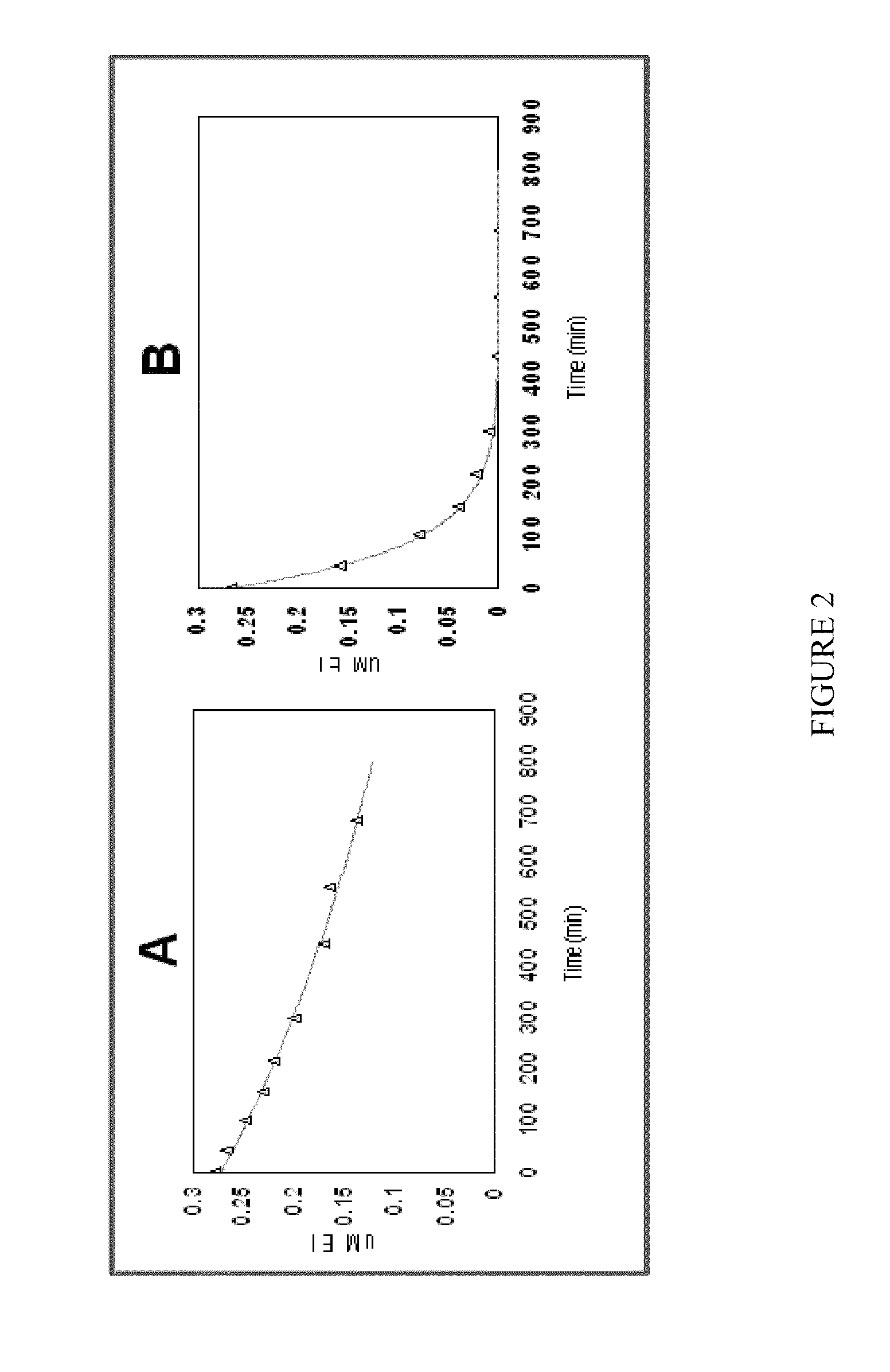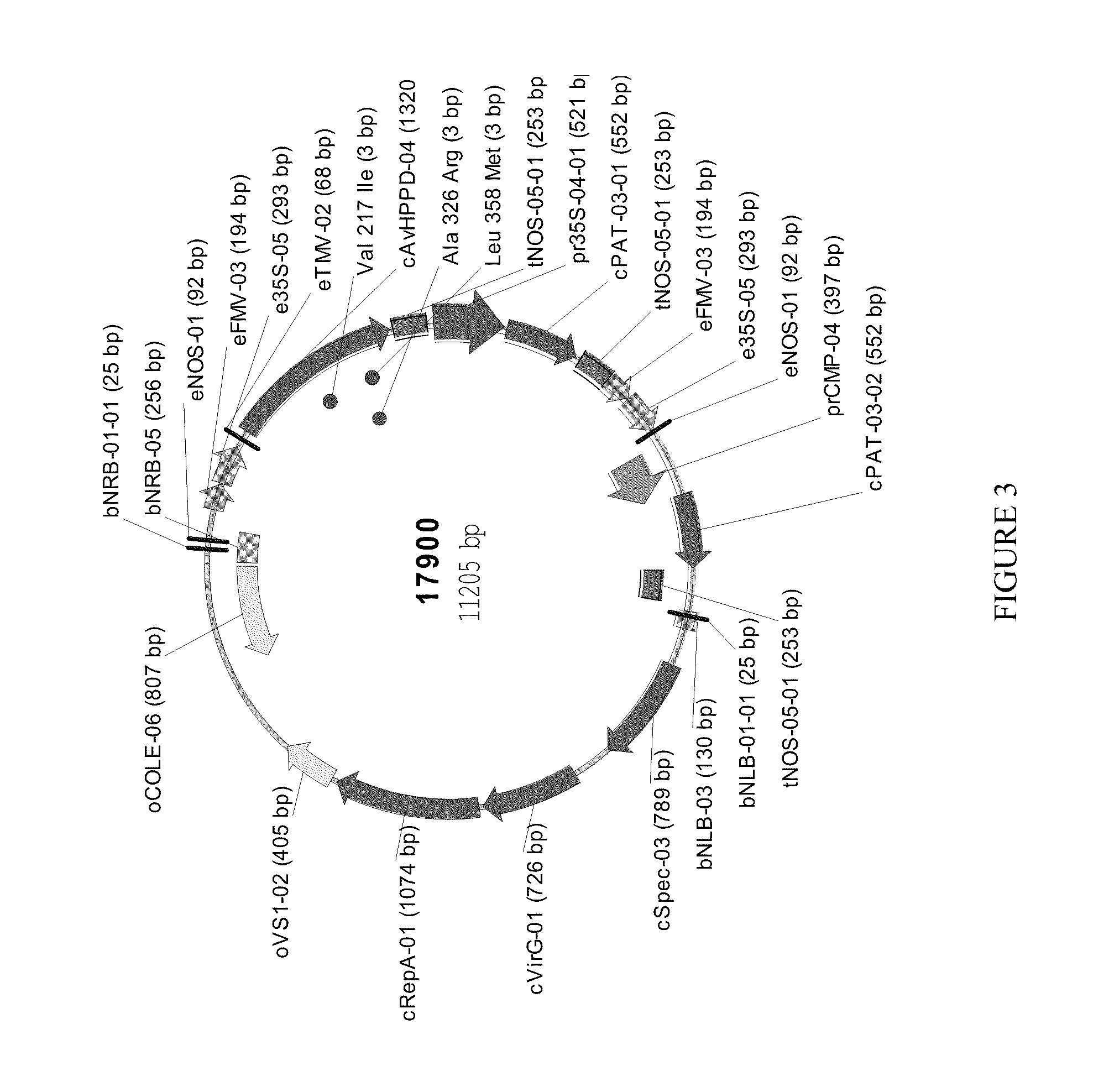Novel hydroxyphenylpyruvate dioxygenase polypeptides and methods of use
a technology of hydroxyphenylpyruvate and polypeptides, which is applied in the field of new hydroxyphenylpyruvate dioxygenase (hppd) polypeptides, can solve the problems of insufficient enzyme kinetic and whole plant data reported so far, and achieve the effect of reducing the number of hppd-inhibitor herbicides and reducing the number of hppd-inhibitors
- Summary
- Abstract
- Description
- Claims
- Application Information
AI Technical Summary
Benefits of technology
Problems solved by technology
Method used
Image
Examples
example 1
[0137]Cloning, expression and assay of Avena-derived HPPD SEQ ID NO: 1 and determination of kcat, KmHpp and koff values versus various HPPD herbicides
[0138]A DNA sequence, codon-optimised for expression in E. coli, was synthesised by GeneArt (Regensburg, Germany) to encode an HPPD derived from Avena sativa (SEQ ID NO: 1), cloned into pET24a and expressed in E. coli BL21(DE3) with 50 μg / ml kanamycin selection as described in PCT Publication No. WO 02 / 46387. Overnight cultures grown at 30° C. were used to inoculate 3×1 litre LB in shake flasks at a ratio of 1:100. Cultures were grown at 37° C., 220 rpm, until an A1cm600 nm of 0.6-0.8 was reached. The temperature was decreased to 15° C. and induced with 0.1 mM IPTG. Cultures were grown overnight, and cells harvested after 15 min centrifugation at 10,000 g. Cells were stored at −20° C. until extraction. A cell pellet from 3 litres of shake flask culture (˜12 g) was thawed in extraction buffer (50 mM Tris, 10 mM sodium ascorbate, 2 mM DT...
example 2
[0186]Cloning, expression and assay of HPPDs SEQ ID NOs: 1-14 from various plants and determination of kcat, KmHPP and koff values versus various HPPD herbicides
[0187]DNA sequences optimized for E. coli codon usage and encoding HPPD polypeptides corresponding to SEQ ID NOs: 1-14 derived from various plants were synthesized by GeneArt (Regensburg, Germany), cloned into pET24a, and expressed in E. coli BL21(DE3) with 50 μg / ml kanamycin selection as described in PCT App. Pub. No. WO 02 / 46387. Cells were grown, protein extracts prepared, and HPPD active site titres and kinetic measurements (of kcat, KmHPP and koff values versus various different herbicides) carried out as described in Example 1.
[0188]The HPPD corresponding to SEQ ID NO: 1 was included as an internal control in experiments. The average absolute values of the various kinetic parameters for SEQ ID NO: 1 are listed above in detail in Example 1. The data in Table 2 below provide data from these measurements for SEQ ID NOs: 2...
example 3
[0193]Cloning, expression and assay of mutant variants of HPPDs and determination of kcat, KmHPP and koff values versus various HPPD herbicides
[0194]DNA sequences optimized for E. coli codon usage and encoding HPPD polypeptides corresponding to SEQ ID NO: S:20-47, encoding HPPD polypeptides derived from Avena sativa, Alopecurus mysoides and Poa annua were synthesized by GeneArt (Regensburg, Germany), cloned into pET24a, and expressed in E. coli BL21(DE3) with 50 μg / mlkanamycin selection as described in PCT Publication No. WO 02 / 46387. Cells were grown, protein extracts were prepared, and HPPD active site titres and kinetic measurements of kcat, KmHPP, and koff values were carried out as described in Example 1.
[0195]Within the present example, the following HPPD sequences derived from SEQ ID NO: 1 were used:
[0196]HPPD SEQ ID NO: 20 was changed relative to SEQ ID NO: 1 by the substitution of M for L at position 358.
[0197]HPPD SEQ ID NO: 21 was changed relative to SEQ ID NO: 1 by the s...
PUM
| Property | Measurement | Unit |
|---|---|---|
| Temperature | aaaaa | aaaaa |
| Temperature | aaaaa | aaaaa |
| Fraction | aaaaa | aaaaa |
Abstract
Description
Claims
Application Information
 Login to view more
Login to view more - R&D Engineer
- R&D Manager
- IP Professional
- Industry Leading Data Capabilities
- Powerful AI technology
- Patent DNA Extraction
Browse by: Latest US Patents, China's latest patents, Technical Efficacy Thesaurus, Application Domain, Technology Topic.
© 2024 PatSnap. All rights reserved.Legal|Privacy policy|Modern Slavery Act Transparency Statement|Sitemap



